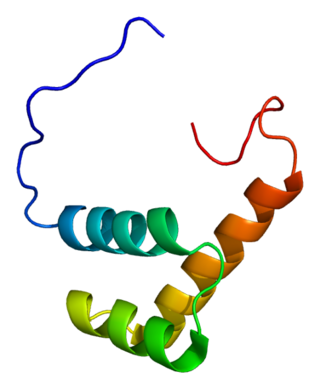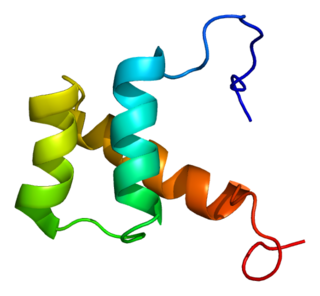This article may be too technical for most readers to understand.(June 2015) |
Homeobox protein DLX-3 is a protein that in humans is encoded by the DLX3 gene. [5] [6]
This article may be too technical for most readers to understand.(June 2015) |
Homeobox protein DLX-3 is a protein that in humans is encoded by the DLX3 gene. [5] [6]
Dlx3 is a crucial regulator of hair follicle differentiation and cycling. Dlx3 transcription is mediated through Wnt, and colocalization of Dlx3 with phospho-SMAD1/5/8 is involved in the regulation of transcription by BMP signaling. [7] Dlx3 transcription is also induced by BMP-2 through transactivation with SMAD1 and SMAD4. [8]
Many vertebrate homeo box-containing genes have been identified on the basis of their sequence similarity with Drosophila developmental genes. Members of the Dlx gene family contain a homeobox that is related to that of Distal-less (Dll), a gene expressed in the head and limbs of the developing fruit fly. The Distal-less (Dlx) family of genes comprises at least 6 different members, DLX1-DLX6. This gene is located in a tail-to-tail configuration with another member of the gene family on the long arm of chromosome 17. [6]
Mutations in this gene have been associated with the autosomal dominant conditions trichodentoosseous syndrome (TDO) and amelogenesis imperfecta with taurodontism. [6]

SMAD4, also called SMAD family member 4, Mothers against decapentaplegic homolog 4, or DPC4 is a highly conserved protein present in all metazoans. It belongs to the SMAD family of transcription factor proteins, which act as mediators of TGF-β signal transduction. The TGFβ family of cytokines regulates critical processes during the lifecycle of metazoans, with important roles during embryo development, tissue homeostasis, regeneration, and immune regulation.

Activin A receptor, type I (ACVR1) is a protein which in humans is encoded by the ACVR1 gene; also known as ALK-2. ACVR1 has been linked to the 2q23-24 region of the genome. This protein is important in the bone morphogenic protein (BMP) pathway which is responsible for the development and repair of the skeletal system. While knock-out models with this gene are in progress, the ACVR1 gene has been connected to fibrodysplasia ossificans progressiva, an extremely rare progressive genetic disease characterized by heterotopic ossification of muscles, tendons and ligaments. It is a bone morphogenetic protein receptor, type 1.
Genes in the DLX family encode homeodomain transcription factors related to the Drosophiladistal-less(Dll) gene. The family has been related to a number of developmental features such as jaws and limbs. The family seems to be well preserved across species. As DLX/Dll are involved in limb development in most of the major phyla, including vertebrates, it has been suggested that Dll was involved in appendage growth in an early bilaterial ancestor.

Growth differentiation factor 6 (GDF6) is a protein that in humans is encoded by the GDF6 gene.

Zinc finger E-box-binding homeobox 2 is a protein that in humans is encoded by the ZEB2 gene. The ZEB2 protein is a transcription factor that plays a role in the transforming growth factor β (TGFβ) signaling pathways that are essential during early fetal development.

Homeobox protein MSX-2 is a protein that in humans is encoded by the MSX2 gene.

Homeobox protein Hox-C8 is a protein that in humans is encoded by the HOXC8 gene.

Homeobox protein Hox-A13 is a protein that in humans is encoded by the HOXA13 gene.

Homeobox protein DLX-5 is a protein that in humans is encoded by the distal-less homeobox 5 gene, or DLX5 gene. DLX5 is a member of the DLX gene family.

Homeobox protein DLX-4 is a protein that in humans is encoded by the DLX4 gene.

Homeobox protein Hox-D12 is a protein that in humans is encoded by the HOXD12 gene.

Homeobox protein Hox-D1 is a protein that in humans is encoded by the HOXD1 gene.

Homeobox protein DLX-2 is a protein that in humans is encoded by the DLX2 gene.

Homeobox protein Hox-C11 is a protein that in humans is encoded by the HOXC11 gene.

Homeobox protein Meis2 is a protein that in humans is encoded by the MEIS2 gene.

Homeobox protein DLX-1 is a protein that in humans is encoded by the DLX1 gene.

Homeobox protein DLX-6 is a protein that in humans is encoded by the DLX6 gene.

Homeobox protein Hox-A2 is a protein that in humans is encoded by the HOXA2 gene.

Short-stature homeobox 2, also known as homeobox protein Og12X or paired-related homeobox protein SHOT, is a protein that in humans is encoded by the SHOX2 gene.

Tricho–dento–osseous syndrome (TDO) is a rare, systemic, autosomal dominant genetic disorder that causes defects in hair, teeth, and bones respectively. This disease is present at birth. TDO has been shown to occur in areas of close geographic proximity and within families; most recent documented cases are in Virginia, Tennessee, and North Carolina. The cause of this disease is a mutation in the DLX3 gene, which controls hair follicle differentiation and induction of bone formation. All patients with TDO have two co-existing conditions called enamel hypoplasia and taurodontism in which the abnormal growth patterns of the teeth result in severe external and internal defects. The hair defects are characterized as being rough, course, with profuse shedding. Hair is curly and kinky at infancy but later straightens. Dental defects are characterized by dark-yellow/brownish colored teeth, thin and/or possibly pitted enamel, that is malformed. The teeth can also look normal in color, but also have a physical impression of extreme fragility and thinness in appearance. Additionally, severe underbites where the top and bottom teeth fail to correctly align may be present; it is common for the affected individual to have a larger, more pronounced lower jaw and longer bones. The physical deformities that TDO causes become more noticeable with age, and emotional support for the family as well as the affected individual is frequently recommended. Adequate treatment for TDO is a team based approach, mostly involving physical therapists, dentists, and oromaxillofacial surgeons. Genetic counseling is also recommended.
This article incorporates text from the United States National Library of Medicine, which is in the public domain.